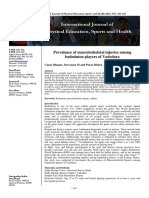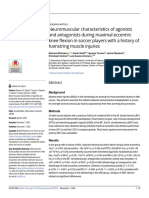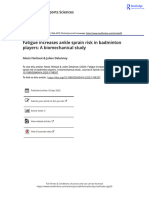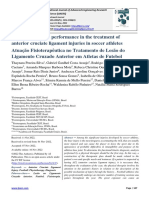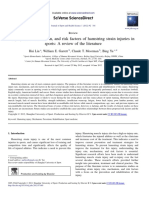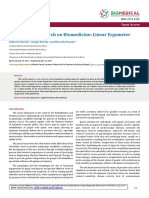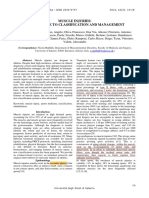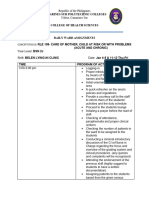Professional Documents
Culture Documents
Musculo-Skeletal Disorder Among Re-Creational Badminton Players of Districts of Arunachal Pradesh
Copyright
Available Formats
Share this document
Did you find this document useful?
Is this content inappropriate?
Report this DocumentCopyright:
Available Formats
Musculo-Skeletal Disorder Among Re-Creational Badminton Players of Districts of Arunachal Pradesh
Copyright:
Available Formats
Volume 7, Issue 11, November – 2022 International Journal of Innovative Science and Research Technology
ISSN No:-2456-2165
Musculo-Skeletal Disorder among Re-Creational
Badminton Players of Districts of Arunachal Pradesh
Racho Kanya1, Ngilyang Mica2
1
BPT Student, 2 Assistant Professor,
Department of Physiotherapy,
Indira Gandhi Technological and Medical Sciences University,
Ziro, Arunachal Pradesh
Abstract:- considered as low-risk sport, dominated by overuse injuries.
Introduction: Badminton, a popular racquet game is a While recovery time from injury is relatively long,
non-contact sport which requires a combination of jumps, Anatomically most injuries are localized to the foot and ankle,
lunges, quick changes in direction and rapid arm with the most frequent injuries being Achilles tendonitis and
movements. During such movements, the body gets tennis elbow5. An injury is defined as an episode of pain,
exposed to various forms of injuries. Hence, it is not swelling, stiffness or numbness during playing badminton or
uncommon for badminton players to sustain various after the game. Badminton injuries as a whole are
injuries during the game. Thus, the purpose of this study predominantly sprains and strains, and not overuse in nature
was to find musculoskeletal disorder among re-creational as widely believed6.
badminton players in the districts of Arunachal Pradesh.
But according to L.D. Hensey, Badminton is a sport of
Method: A cross sectional survey was carried out on 100 relatively low risk and that the majority of related injuries
badminton players using Modified Nordic were chronic overuse injuries7. It is a fast sport that requires
Musculoskeletal Questionnaire to find the prevalence of quick movements and sudden changes of direction. Injuries
musculoskeletal problems in re-creational badminton in sports are common due to contact with players, ground,
players of districts of Arunachal Pradesh. objects and other reasons such us pressure, overuse and fall.
Weakness is also a common cause of injuries. There are
Result: The study revealed that highest numbers of factors to be considered like knowing injury extension, the
players were between the age group of 22-25 years with 38 mechanism, and the preventive strategies. Proper training and
subjects. The maximum players were affected in treatment can help in protecting the damaged tissues which
wrist/hand with 44% during the last 12 months. 27% of will help healing in the inflammatory stage and pain control.
players reported having low back pain during the past 7 In addition, it helps in muscle flexibility, strength,
days and highest numbers of players’ ADLs were affected Proprioception, and balance in improving the game
by wrist pain during the past 12 months with 28% performance8. Repetitive loading during the performance of
followed by shoulder with 22%. the different kinds of strokes is the typical injury mechanism
in badminton. The overuse injury mechanism in badminton
Conclusion: The most common injuries sustained by is, however, as in most other sports less documented and more
recreational badminton players were Wrist/hand speculative, due to its multifactorial origin. Achilles tendon
followed by shoulder injuries. injuries in badminton could be due to a combined effect of the
Keywords:- Musculoskeletal disorders, badminton players, special footwork with fast forward movement/stop with
recreational badminton player, sport injuries, overuse forceful heel strike and eccentric work by the Triceps Surae
injuries. (TS) alternating with backwards toe running and concentric
work of the TS and backward or combined back/sideward
I. INTRODUCTION jumps with forceful eccentric work by the TS. Injuries could
also be caused by chronically practicing movements that
Badminton is one of the most widely-played sports in produce alternating fast changing movements that cause high
the world and the second most played sport in INDIA1. The tension on the Achilles tendon, which could produce
Badminton World Federation (BWF) estimated that about microtrauma5.
150 million people play the game worldwide2. It is a popular
non-contact, racquet sport which requires combination of The important factors for badminton players are muscle
jumps, lunges, quick changes in direction, burst actives and strength, muscular endurance, power, speed, agility,
rapid arm movements in various awkward body postures3. flexibility, balance and coordination. Functional movements
During such movements, the body may be susceptible to are highly dependent on this part of the body, and lack of core
various injuries. Therefore, it is common for badminton muscular development can result in predisposition of injury9.
players to get different injuries during the game. Hence it is Core muscles includes transverse abdominal muscle,
uncommon for badminton players to sustain various injuries abdominal external oblique muscle, multifidus muscles,
during the game4. Although badminton is one of the most abdominal internal oblique, psoas major muscle. A core
frequently played sports in the world, it has received little muscle is used to stabilize the thorax and pelvis during
interest from sports medicine specialists. Based on the few dynamic movement and it also provides internal pressure to
existing studies on injuries in badminton, badminton is expel substances. Static core functionally is the ability of
IJISRT22NOV905 www.ijisrt.com 1522
Volume 7, Issue 11, November – 2022 International Journal of Innovative Science and Research Technology
ISSN No:-2456-2165
one’s core to align the skeleton to resist a force that does not about the sport that mainly affects the shoulder, wrist and low
change. The core strength training plays an important role in back region comparing to other areas19.
reducing and preventing lower and knee joint injuries10.
This study was aimed to provide objective data and
The injuries in badminton can be recognized on the basis information for physiotherapists working in Arunachal
of type of injuries, severity and body part. There are many Pradesh at recreational clubs, badminton institutes etc. to
prevalence studies stating that there are more of ankle and develop a better plan of training advice for players thereby to
knee injuries11. reduce risk of injury, which in turn will help to improve the
player’s performance more effectively. This study will also
As badminton is the second most popular sport in India, provide important information for badminton player in
it is necessary to understand the injury prevalence, so as to Arunachal Pradesh to understand more about the injury
predict risk factors and to set up preventive measures to patterns and predicting their causes so as to prevent them.
prevent injuries. Also to make awareness for coaches to Therefore the study was conducted to find out the prevalence
develop a better plan for training thereby reduce risk of injury of musculoskeletal disorder among the re-creational
and improve training quality6. Due to huge force involved in badminton players of district of Arunachal Pradesh.
badminton while jumping and other movements it is expected
that injuries would occur. Ankle, shoulder, and knee injuries II. AIM AND OBJECTIVE OF THE STUDY
are common injuries in badminton which needs rehabilitation.
It is recognized that the overall injuries in badminton is low A. Aim of the study:
comparing to other sports8. Furthermore, badminton match The aim of the study is to examine the prevalence of
requires high intensity intermittent actions within short musculoskeletal disorder among re-creational badminton
resting period12. Fatigue may affect the neuromuscular player of districts of Arunachal Pradesh.
control of lower limb, which is susceptible to increase the risk
of injuries13. Other studies showed the majority of injuries B. Objective of the study:
among badminton players occurred in lower extremities, To determine the prevalence of musculoskeletal
which might be due to rapid movements required in this disorder among re-creational badminton players of
game. Currently only limited evidence is available about the districts of Arunachal Pradesh.
relationship between risk factors and lower extremity injuries To find out the most prevalent region of disorder among
among re-creational badminton players14. re-creational badminton player of Arunachal Pradseh.
Hitting the shuttlecock in badminton places a high III. METHODOLOGY
degree of force on the shoulder joint, and a characteristic
feature of this sport is that it requires more shoulder mobility Source of data: 5 Districts of Arunachal Pradesh (Lower
than other sports. Arm rotation, particularly at the shoulder, Subansiri, Papumpare, East Kaming, West Siang, Kra
is an important component of strokes, and stroke repetition Dadi).
increases the load on the shoulder15. The injuries in
Study setting: Badminton clubs, local youth clubs
badminton can be recognized on the basis of type of injuries,
severity and body part. It is necessary to understand the Sampling method: Convenient.
injury prevalence, so as to predict risk factors and to set up
preventive measures to prevent injuries16. High prevalence Sample size: 100 recreational badminton players
rate of musculoskeletal disorders indicates that it is necessary
to organize the training courses about sports and coaching Inclusion Criteria:
intervention in order to raise players’ awareness and skills. Re-creational badminton players
These programs can be used to improve the health of players Age group 18- 30
by preventing from the occurrence of musculoskeletal Players playing for 12 months
disorders17. Players playing baminton with others sports too
A retrospective study carried out in Hong Kong on elite Exclusive Criteria:
badminton players showed that sprains were the most Players with injuries within one month of duration.
common type of injuries, and that the back, shoulder, thigh Players with previous formal badminton training.
and knee were the most common areas involved18. Studies Players with neurological and systemic disorders.
reporting injuries in recreational badminton players are
limited. Thus, the purpose of this study was to describe Procedure:
common injuries sustained by recreational badminton A survey was conducted to examine the prevalence of
players4. Risk factors for lower limb injuries need to be musculoskeletal disorder among re-creational badminton
investigated to help develop appropriate preventive measures. players of districts of Arunachal Pradesh. An approval was
Thus, the study was aimed to analyze the relationship of obtained from the Indira Gandhi Technology and Medical
demographic and physical characteristics to lower limb Science University, Ziro. 20 re-creational players were
injuries in badminton players14. A study conducted by J. selected from each 5 districts of Arunachal Pradesh (Lower
Suresh et al concluded that there is high prevalence rate of Subansiri, Papumpare, Kara Dadi, East Kameng, West
varied musculoskeletal disorders in recreational badminton Siang). A total of 100 re-creational badminton players were
players which is due to improper training and awareness selected randomly considering inclusion and exclusion
IJISRT22NOV905 www.ijisrt.com 1523
Volume 7, Issue 11, November – 2022 International Journal of Innovative Science and Research Technology
ISSN No:-2456-2165
criteria. The players were made aware of the purpose of the Hips/Thigh/Buttocks, Knees Ankles) and category of injury
study and a consent form were taken. Each player’s ( Muscular pain, Sprain, Strain, Fracture, Dislocation) was
demographic data, performa were taken and all component noted. The distribution of the form started from Feb. 26
of Nordic Musculoskeletal Questionnaire were explained to 2022 and it took about 3& half months to complete the data
each and every player. Players were asked to recall the collection. The total of all 100 re-creational players
injuries they sustained in last one year and along with responded to the questionnaire and they with full
players have been prevented from carrying out normal cooperation completed their questionnaire form and
activities during past 12 month and the injuries they submitted and the results were analyzed using (Microsoft
sustained in last 1 week as on the following anatomical site Office Excel) Graphs and tables.
of injury (Neck, Shoulders, Elbow, Wrists/Hands, Back,
IV. RESULT
Group
40
35
30
25
Group
20
15
10
Age of the
5
players
0
18-21 22-25 25-30
Fig. 1: Age Group Distribution
The subjects were divided three groups into according highest number of recreational badminton players were
to their age; Group – A (18-21) 25 subjects, Group – B (22- between the age group of 22-25 years with 38 subjects.
25) 38 subjects and Group – C (25-30) 37, the study showed
IJISRT22NOV905 www.ijisrt.com 1524
Volume 7, Issue 11, November – 2022 International Journal of Innovative Science and Research Technology
ISSN No:-2456-2165
GRAPH 2 Neck Injury
90
80
70
60
Number of participants
50
40
30
20
10
0
have you at any time during the last 12 have you had trouble
during the last 12 month have you been during the last 7 days
months had trouble prevented from
(such as ache, carrying out normal
pain,discomfort , activities(eg-
numbness) in: job/house, hobbies)
because of this trouble
Neck yes 18 13 15
Neck no 82 87 85
Fig. 2: Prevalence of Neck disorder
The present study showed that 18 out of 100 re- prevented from carrying out normal activities during past 12
creational badminton players have had trouble on neck during month and 15 out of 100 players complain of repetitive neck
past 12 months. Out of 18 subjects, 13 of them have been pain within past 1 week.
IJISRT22NOV905 www.ijisrt.com 1525
Volume 7, Issue 11, November – 2022 International Journal of Innovative Science and Research Technology
ISSN No:-2456-2165
Shoulder Injury
GRAPH 3 90
80
70
60
Number of participation
50
40
30
20
10
0
in right side in left in both
no yes
shoulder
have you at any time during the last
12 months had trouble (such as
55 30 6 9
ache, pain,discomfort , numbness)
in:
during the last 12 month have you
been prevented from carrying out
78 22
normal activities(eg-job/house,
hobbies) because of this trouble
have you had trouble during the last
71 21 3 5
7 days
Fig. 3: Prevalence of Shoulder Disorder
The present study shows that 45 out of 100 re-creational carrying out normal activities during past 12 months. On
badminton players have trouble on shoulder during past 12 further, we found 29 out of 100 players complain of repetitive
months. Out of 45 only 22 of them have been prevented from shoulder pain within past 1 week.
IJISRT22NOV905 www.ijisrt.com 1526
Volume 7, Issue 11, November – 2022 International Journal of Innovative Science and Research Technology
ISSN No:-2456-2165
Elbow Injury
GRAPH 4
90
80
70
60
Number of participation
50
40
30
20
10
0
in right side in left in both
no yes
elbows
have you at any time during the last
12 months had trouble (such as
83 15 2 0
ache, pain,discomfort , numbness)
in:
during the last 12 month have you
been prevented from carrying out
89 11
normal activities(eg-job/house,
hobbies) because of this trouble
have you had trouble during the last
84 11 4 1
7 days
Fig. 4: Prevalence of Elbow Disorder
The present study shows that 17 out of 100 re-creational carrying out normal activities during past 12 months. On
badminton players have trouble on elbow during past 12 further, we found 15 out of 100 players complain of repetitive
months. Out of 17 only 11 of them have been prevented from elbow pain within past 1 week.
IJISRT22NOV905 www.ijisrt.com 1527
Volume 7, Issue 11, November – 2022 International Journal of Innovative Science and Research Technology
ISSN No:-2456-2165
Wrist/Hand Injury
GRAPH 5
80
70
60
Number of participation
50
40
30
20
10
0
in right side in left in both
no yes
wrist / hand
have you at any time during the last
12 months had trouble (such as
53 44 3 0
ache, pain,discomfort , numbness)
in:
during the last 12 month have you
been prevented from carrying out
72 28
normal activities(eg-job/house,
hobbies) because of this trouble
have you had trouble during the last
70 25 4 1
7 days
Fig. 5: Prevalence of Wrist/Hand Disorder
The present study shows that 47 out of 100 re-creational carrying out normal activities during past 12 months. On
badminton players have trouble on wrist/hand during past 12 further, we found 30 out of 100 players complain of repetitive
months. Out of 47 only 28 of them have been prevented from wrist/hand pain within past 1 week.
IJISRT22NOV905 www.ijisrt.com 1528
Volume 7, Issue 11, November – 2022 International Journal of Innovative Science and Research Technology
ISSN No:-2456-2165
Upper back injury
GRAPH 6
100
90
80
70
Number of perticipation
60
50
40
30
20
10
0
have you at any time during the last 12 have you had trouble
during the last 12 month have you been during the last 7 days
months had trouble prevented from carrying
(such as ache, out normal
pain,discomfort , activities(eg-job/house,
numbness) in: hobbies) because of this
trouble
upper back yes 15 6 20
upper back no 85 94 80
Fig. 6: Prevalence of Upper back Disorder
The present study shows that 15 out of 100 re-creational carrying out normal activities during past 12 months. On
badminton players have trouble on upper back during past 12 further, we found 20 out of 100 players complain of repetitive
months. Out of 15 only 06 of them have been prevented from upper back pain within past 1 week.
IJISRT22NOV905 www.ijisrt.com 1529
Volume 7, Issue 11, November – 2022 International Journal of Innovative Science and Research Technology
ISSN No:-2456-2165
Lower Back Injury
GRAPH 7
100
90
80
70
number of participation
60
50
40
30
20
10
0
have you at any time during the last 12 have you had trouble
during the last 12 month have you been during the last 7 days
months had trouble prevented from
(such as ache, carrying out normal
pain,discomfort , activities(eg-job/house,
numbness) in: hobbies) because of
this trouble
lower back yes 24 8 27
lower back no 76 92 73
Fig. 7: Prevalence of Lower back Disorder
The present study shows that 24 out of 100 re-creational from carrying out normal activities during last 12 months. On
badminton players have trouble on low back pain during past further, we found 27 out of 100 players complain of repetitive
12 months. Out of 24 only 08 of them have been prevented low back pain within past 1 week.
IJISRT22NOV905 www.ijisrt.com 1530
Volume 7, Issue 11, November – 2022 International Journal of Innovative Science and Research Technology
ISSN No:-2456-2165
Hip/Thigh/Buttock Disorder
100
GRAPH 8
90
80
number of participation
70
60
50
40
30
20
10
0
have you at during the last have you had
any time 12 month have trouble during
during the last you been the last 7 days
12 months had prevented from
trouble (such carrying out
as ache, normal
pain,discomfor activities(eg-
t , numbness) job/house,
in: hobbies)
because of this
trouble
one or both - hip/thigh/buttock yes 10 2 6
one or both - hip/thigh/buttock no 90 98 94
Fig. 8: Prevalence of Hip/thigh/buttock disorder
The present study shows that 10 out of 100 re-creational prevented from carrying out normal activities during past 12
badminton players have trouble on hip/thigh/buttock during months. On further, we found 6 out of 100 players complain
past 12 months. Out of 10 only 02 of them have been of repetitive hip/thigh/buttock pain within past 1 week.
IJISRT22NOV905 www.ijisrt.com 1531
Volume 7, Issue 11, November – 2022 International Journal of Innovative Science and Research Technology
ISSN No:-2456-2165
Knee injury
GRAPH 9
100
90
Number of perticipation
80
70
60
50
40
30
20
10
0
have you at any time during the last 12 have you had trouble
during the last 12 month have you been during the last 7 days
months had trouble prevented from
(such as ache, carrying out normal
pain,discomfort , activities(eg-job/house,
numbness) in: hobbies) because of
this trouble
one or both knees yes 25 7 16
one or both knees no 75 93 84
Fig. 9: Prevalence of Knee disorder
The study shows that 25 out of 100 re-creational carrying out normal activities during past 12 months. On
badminton players have trouble on knee during past 12 further, we found 16 out of 100 players complain of repetitive
months. Out of 25 only 07 of them have been prevented from knee pain within past 1 week.
IJISRT22NOV905 www.ijisrt.com 1532
Volume 7, Issue 11, November – 2022 International Journal of Innovative Science and Research Technology
ISSN No:-2456-2165
Ankle/feet Disorder
GRAPH 10
100
Number of participation 90
80
70
60
50
40
30
20
10
0
have you at any during the last 12 have you had
time during the month have you trouble during
last 12 months been prevented the last 7 days
had trouble (such from carrying out
as ache, normal
pain,discomfort , activities(eg-
numbness) in: job/house,
hobbies) because
of this trouble
one or both ankle / feet yes 18 4 20
one or both ankle / feet no 82 96 80
Fig. 10: Prevalence of Ankle/feet Disorder
The study shows that 18 out of 100 re-creational carrying out normal activities during past 12 months. On
badminton players have troubled on ankle/feet during past 12 further, we found 20 out of 100 players complain of repetitive
months. Out of 18 only 04 of them have been prevented from ankle/feet pain within past 1 week.
IJISRT22NOV905 www.ijisrt.com 1533
Volume 7, Issue 11, November – 2022 International Journal of Innovative Science and Research Technology
ISSN No:-2456-2165
Pain in body parts Prevalence (%) of Prevalence (%) of Prevalence (%) of
disorder during past 12 disorder during disorders affecting ADLS
months past 7 days during past 12 months
Neck 18 15 13
Shoulder Right 30 21
Left 6 3 22
Both 9 5
Elbow Right 15 11
Left 2 4 11
Both 0 1
Wrist Right 44 25
Left 3 4 28
Both 0 1
Upper Back 15 20 6
Lower Back 24 27 8
Hips 10 6 2
Knee 25 16 7
Ankle 18 20 4
Table 1: The Prevalence of Musculoskeletal Disorders in recreational badminton players during last 12 months
Table 1 shows that maximum players were affected in In our study we focused on every joint of the body but
wrist/hand with 44% during the last 12 months. 27 out of 100 in this similar study they focused on the joints of lower limb.
players reported having low back pain during the past 7 days A study on Risk factors for lower extremity injuries in young
and highest numbers of players’ ADLs were affected by wrist badminton players was conducted by Ang Lin Kang,
pain during the past 12 months with 28% followed by Vinodhkumar Ramalingam, a total of 106 Malaysian young
shoulder with 22%. badminton players (83 males, 23 females) were recruited.
Players were from national level (n=4), state level (n=41),
The result showed highest numbers of participants were district level (n=4), clubs (n=13), high school (n=21) and
between the age groups of 22-25 years with 38 players and recreational players (n=23). Forty-two players with reported
prevalence of musculoskeletal disorder of re-creational injuries were included in the case group, and 64 players with
badminton players were highest in wrist/hand with 44% in no reported injuries were included in the control group. Data
past 12 months as compare to any other analysis reported the occurrence of 60 lower extremity
joints/musculoskeletal pain. The study also showed that injuries among the 42 case group players. Ankle joint injury
maximum difficulty in performing activity of daily living was the most common lower extremity injury (63.3%)
during the past12 months among the participants were due to amongst the participants14.
wrist/hand disorder with 28%. And 27 players had complaint
of low back disorder during past 7 days. VI. CONCLUSION
V. DISCUSSION The most common injuries sustained by recreational
badminton players were Wrist/hand and shoulder injuries
In this study, the result showed highest prevalence of followed by low back, knee injuries. Other type of injury
musculoskeletal disorder of re-creational badminton players which includes muscle cramp and muscle catch was the most
in wrist/hand and shoulder as compare to any other common type of injuries. These were followed by
joints/musculoskeletal disorders during the past 12 months. A strain/sprain. Most of the injuries are not serious enough to
similar study on common injuries in Re-creational badminton warrant any form of surgical intervention. Most badminton
players were conducted by A Muttalib et al and it was players were knowledgeable about the appropriate ways to
concluded that the most common injuries sustained by prevent these injuries. In general, badminton is a sport of
recreational badminton players were shoulder and back relatively low risk and its related injuries are generally
injuries4. chronic overuse injuries.
Musculoskeletal problems in badminton players VII. LIMITATION OF THE STUDY
under17 were conducted by P Sathya and Labdhi Doshi, and
the study concluded that the prevalence of musculoskeletal During this study it was found that there are higher number
problems is more in club level and school level players. of footballer players than a badminton player in the districts
Wrist/ Hands were the most commonly injured region of Arunachal Pradesh. Therefore it was difficult to find
followed by Shoulder and Neck which is similar to the result subjects for the study.
of this study. The study also concluded that in the type of Female are less in players as compare to male.
injury majority of players had other type of injury (53%) in Current study was only determine to find the prevalence of
the body parts which includes Muscle Catch and Muscle musculoskeletal disorder among re-creational badminton
Cramp followed by Strain (23%) and Sprain (20%)6. player and did not include management to prevent
musculoskeletal disorder.
IJISRT22NOV905 www.ijisrt.com 1534
Volume 7, Issue 11, November – 2022 International Journal of Innovative Science and Research Technology
ISSN No:-2456-2165
Ethical clearance- An approval was obtained from [14.] Kang AL, Ramalingam V. Risk factors for lower
Registrar, Indira Gandhi Technology and Medical Science extremity injuries in young badminton players. Sci
University, Ziro to initiate the research porject. Med. 2018;28(2):ID28939. Doi: 10.15448/1980-
6108.2018.2.28.939.
Source of Funding- Self. [15.] Risk Factors for Shoulder Pain in Japanese Badminton
Players: A Quantitative-Research Survey. J Sports
Conflict of Interest- Nil Sci. 2018 Apr;6:84-93, doi: 10.17265/2332-
7839/2018.02.003.
REFERENCES [16.] Dutta P, SV Kumar K. A literature review on
[1.] Phomsoupha M, Laffaye G. The science of “Prevalence and causes of common musculoskeletal
badminton: game characteristics, anthropometry, injuries in badminton players. 2021 Apr; 2(1):1-4.
physiology, visual fitness and biomechanics. Sports DOI: 10.51542/ijscia.spi1.01.
Med. 2015 Apr; 45(4):473-95. Doi: 10.1007/s40279- [17.] Hausswirth C, Mujika I. Recovery for performance in
014-0287-2. badminton. Champaign: Human Kinetics. 2013: 71-
[2.] Badminton World Federation. Players worldwide. In: 81.DOI: https:/doi.org/10.1123/jab.2012-0151
Badminton World Federation [online]. Available at: [18.] Yung PS, Chan RH, Wong FC, Cheuk PW, Fong DT.
old.internationalbadminton.org/players.asp. Accessed Epidemiology of injuries in Hong Kong elite
June 20, 2022. badminton athletes. Res Sports Med, 2007;15(2):133-
[3.] Shariff AH, George J, Ramlan AA. Musculoskeletal 46 https://doi.org/10.1080/15438620701405263
injuries among Malaysian badminton players. [19.] Juge AD, Vorak J. Badminton injuries during the
Singapore Med J. 2009 Nov; 50(11):1095-7. PMID: World cup 2002. AMJ sports med. 2004:32.
19960167. [20.] Ali Md Nadzalan, Nur Ikhwan Mohamad, Jeffrey Lo.
[4.] Muttalib A, Zaidi M. A survey on common injuries in The Effects of Step Versus Jump Forward Lunge
Re-creational badminton players. Malaysian Exercise Training on Muscle Architecture among
Orthopaedic Journal. 2009; 3(2):8-11. Recreational Badminton Players. 2017.
Doi:10.5704/MOJ.0911.002 https://www.researchgate.net/publication/320442470.
[5.] Suresh TN, R. Shylaja R, Asokan SA. Prevalence of [21.] Hassan IH, Elgammal MA. Common Injuries in
achilles tendinopathy among recreational badminton Racket Sports: A Mini Review. Orthopedic surgery
players. Int J Pharma Bio Sci. 2018 Jan;9(1): (B) 229- and Orthopedic care International journal. 2018 Mar.
31. Doi: 10.22376/ijpbs.2018.9.1.b229-231. Doi: 10.31031/OOIJ.2018.01.000519.
[6.] Sathya P, Doshi L. Musculoskeletal problems in [22.] Rangasamy K, Sharma S, Gopinathan NR. Risk
badminton players under 17. Int J Phys Educ Sports Prediction of Injury Among Recreational Badminton
Health. 2018;5(5):67-70. PMID: 19960167. Players in India. Indian J Orthop. 2022 Jun;
[7.] Hensley LD, Paup DC. A survey of badminton 56(8):1378–84. Doi: 10.1007/s43465-022-00663-y.
injuries. Brit. J Sports Med. 1979 Dec; 13:156-60.
Doi: 10.1136/bjsm.13.4.156.
[8.] Suresh J, Sri Shankar M, Rameshkumar S. Prevalence
of musculoskeletal disorders in recreational
badminton players. Int J of Phy Edu and Yoga.
2019;4(5).
[9.] Karageanes Steven J. Principle of manual sports
medicines. Lippincott Williams &
Wilkins.Phi;Adelphia. 2005, Pg. 510-511.
[10.] Leetun D.T, Ireland M.L, Willson J.D, Ballantyne
B.T, Davus I.M. Core stability measures as risk factors
for lower extremity injury in athletes. Med Sci. Sports
Exerc. 2004 Jun; 36(6):926-34. Doi:
10.1249/01.mss.0000128145.75199.c3.
[11.] Hay K, Lindblad BE, Terkelsen CJ, Helleland HE,
Terkelsen CJ. Badminton injuries - a prospective
epidemiological and socioeconomic study. Br J Sports
Med. 1994 Dec; 28(4):276-79. Doi:
10.1136/bjsm.28.4.276.
[12.] Faude O, Meyer T, Fries M, Kindermann W.
Physiological testing in badminton. Science and
Racket Sports IV. New York: Routledge. 2008. p. 5-
10.
[13.] Murphy D. Risk factors for lower extremity injury: a
review of the literature. Br J Sports Med. 2003 Feb;
37(1):13-29. Doi: 10.1136/bjsm.37.1.13
IJISRT22NOV905 www.ijisrt.com 1535
You might also like
- Hamstring RehabilitationDocument29 pagesHamstring RehabilitationOscar NgNo ratings yet
- Cairo: Pilbeam's Mechanical Ventilation, 6th EditionDocument7 pagesCairo: Pilbeam's Mechanical Ventilation, 6th EditionLesly Peinado Torres100% (1)
- Hip & Groin Pain DD PDFDocument15 pagesHip & Groin Pain DD PDFagniosaiNo ratings yet
- Pulmonary TB RadiologyDocument45 pagesPulmonary TB RadiologyArina Windri RivartiNo ratings yet
- Cysts of The JawsDocument75 pagesCysts of The JawsSwetha KaripineniNo ratings yet
- Can Mindfulness in Health Care Professionals Improve Patient Care An Integrative Review and Proposed Model.Document15 pagesCan Mindfulness in Health Care Professionals Improve Patient Care An Integrative Review and Proposed Model.ALIXNo ratings yet
- Change Your Life in 7 Days With NLP - Paul Mckenna BrochureDocument2 pagesChange Your Life in 7 Days With NLP - Paul Mckenna Brochureapi-385316675% (4)
- Common Injuries in Kabaddi Play and Their Prevention With The Help of BiomechanicsDocument4 pagesCommon Injuries in Kabaddi Play and Their Prevention With The Help of BiomechanicsVansh MalviyaNo ratings yet
- Basu Comp Study IASTM Vs Ischemic MTPDocument7 pagesBasu Comp Study IASTM Vs Ischemic MTPAnshu yadavNo ratings yet
- Myofascial Release and Superficial Backline Stretching On Hamstring Strain in Cricket Players: An Interventional StudyDocument8 pagesMyofascial Release and Superficial Backline Stretching On Hamstring Strain in Cricket Players: An Interventional StudyIJAR JOURNALNo ratings yet
- Badminton Injuries in Elite Athletes: A Review of Epidemiology and BiomechanicsDocument9 pagesBadminton Injuries in Elite Athletes: A Review of Epidemiology and BiomechanicsAmbusam SubramaniamNo ratings yet
- Epidemiological Review of Badminton RelaDocument3 pagesEpidemiological Review of Badminton RelaAmbusam SubramaniamNo ratings yet
- BrJSportsMed 2012 Mendiguchia Bjsports 2012 091250Document11 pagesBrJSportsMed 2012 Mendiguchia Bjsports 2012 091250emavassNo ratings yet
- The Role of Preventive Practice in ReducingDocument6 pagesThe Role of Preventive Practice in ReducingPVSE INFO6No ratings yet
- International Journal of Chemtech Research: Nabil .A. Mohamed and Maha. M. MohamedDocument11 pagesInternational Journal of Chemtech Research: Nabil .A. Mohamed and Maha. M. MohamedHari25885No ratings yet
- Volleyball InjuryDocument7 pagesVolleyball InjuryAnggia PNo ratings yet
- Sports Injuries Prevention and TreatmentDocument4 pagesSports Injuries Prevention and TreatmentPatrick JeffersonNo ratings yet
- Br+J+Sports+Med 2012 Mendiguchia Bjsports 2012 091250Document11 pagesBr+J+Sports+Med 2012 Mendiguchia Bjsports 2012 091250Kostas LiougkosNo ratings yet
- Lesiones de Recto Femoral en El FutbolDocument11 pagesLesiones de Recto Femoral en El FutbolOscar MadroñeroNo ratings yet
- Mendiguchia 2012 Rectus Femoris Muscle Injuries in Football-A Clinically Relevant Review of Mechanisms of Injury, Risk Factors and Preventive Strategies PDFDocument11 pagesMendiguchia 2012 Rectus Femoris Muscle Injuries in Football-A Clinically Relevant Review of Mechanisms of Injury, Risk Factors and Preventive Strategies PDFJuan PalomoNo ratings yet
- (ACC) Repetitive Microtrauma in Glenohumeral Joint During Sports Activities On AthleteDocument10 pages(ACC) Repetitive Microtrauma in Glenohumeral Joint During Sports Activities On AthleteputriNo ratings yet
- Effectiveness of Core Strengthening Exercises To Reduce Incidence of Side Strain Injury in Medium Pace BowlersDocument12 pagesEffectiveness of Core Strengthening Exercises To Reduce Incidence of Side Strain Injury in Medium Pace BowlersDr. Krishna N. SharmaNo ratings yet
- Prevention Program in Anterior Cruciate Ligament (ACL) Among Indonesian's Athletes - Reviewed 202209122Document17 pagesPrevention Program in Anterior Cruciate Ligament (ACL) Among Indonesian's Athletes - Reviewed 202209122dewa aryNo ratings yet
- UntitledDocument19 pagesUntitledJosé Pedro CorreiaNo ratings yet
- UEU Journal 20985 11 - 1778Document9 pagesUEU Journal 20985 11 - 177820mutiara balqiesNo ratings yet
- Prevention Program in Anterior Cruciate Ligament (ACL) Among Indonesian's Athletes - Review Study Manuscript 1Document17 pagesPrevention Program in Anterior Cruciate Ligament (ACL) Among Indonesian's Athletes - Review Study Manuscript 1sd negeri 2 batununggulNo ratings yet
- The Causes And Prevention Of Injuries In Handball: ТEME, г. XLIV, бр. 2, априлDocument16 pagesThe Causes And Prevention Of Injuries In Handball: ТEME, г. XLIV, бр. 2, априлGiorgianaNo ratings yet
- Research Article Prevention of Physical Risk and Rehabilitation of Muscle Injury in Sanda CompetitionDocument9 pagesResearch Article Prevention of Physical Risk and Rehabilitation of Muscle Injury in Sanda Competition壮No ratings yet
- Sports Injury and Rehabilitation of The Shoulder Joint in VolleyballDocument4 pagesSports Injury and Rehabilitation of The Shoulder Joint in VolleyballRodrigoNo ratings yet
- Sprain and Strain - Their Management and Rehabilitation: Aafid GulamDocument4 pagesSprain and Strain - Their Management and Rehabilitation: Aafid GulamDwiki GumelarNo ratings yet
- Volume 1 Number 1 Article 4Document5 pagesVolume 1 Number 1 Article 4Patrick JeffersonNo ratings yet
- Mechanism For Shoulder Pain and Injury in Elite Badminton PlayersDocument12 pagesMechanism For Shoulder Pain and Injury in Elite Badminton PlayersNanda PratamaNo ratings yet
- Jurnal 4Document13 pagesJurnal 4DesyaNo ratings yet
- 2020 Fatigue increases ankle sprain risk in badminton playersDocument7 pages2020 Fatigue increases ankle sprain risk in badminton playersktan.lboroNo ratings yet
- Physical Exercises For Preventing Injuries Among Adult Male Football Players PDFDocument8 pagesPhysical Exercises For Preventing Injuries Among Adult Male Football Players PDFInês AntunesNo ratings yet
- Physiotherapeutic Performance in The Treatment of Anterior Cruciate Ligament Injuries in Soccer AthletesDocument7 pagesPhysiotherapeutic Performance in The Treatment of Anterior Cruciate Ligament Injuries in Soccer AthletesIJAERS JOURNALNo ratings yet
- Prevalence and Pattern of Injuries Among Varsity Basketball PlayersDocument5 pagesPrevalence and Pattern of Injuries Among Varsity Basketball PlayersANIENo ratings yet
- Kenya Luiz Artigo1- CorexombroDocument6 pagesKenya Luiz Artigo1- CorexombrolaurinhadeandradeNo ratings yet
- 2018 Abadi Et Al. A Comparative Study of Water and Land Based Exercises Training Program On Stability and Range of MotionDocument6 pages2018 Abadi Et Al. A Comparative Study of Water and Land Based Exercises Training Program On Stability and Range of MotionNathalia Bakes TeodoroNo ratings yet
- Basketball Injuries - Definition and AnatomyDocument3 pagesBasketball Injuries - Definition and AnatomysinghmenkaNo ratings yet
- 1 s2.0 S2095254612000452 Main PDFDocument10 pages1 s2.0 S2095254612000452 Main PDFanettepardedeNo ratings yet
- Prevalence of Musculoskeletal Problems in Cricket Players: August 2017Document7 pagesPrevalence of Musculoskeletal Problems in Cricket Players: August 2017Kaushik Dipto RoyNo ratings yet
- Posterior Shoulder Tightness and Rotator Cuff Strength Assessments in Painful Shoulders of Amateur Tennis Players RBF 2013Document10 pagesPosterior Shoulder Tightness and Rotator Cuff Strength Assessments in Painful Shoulders of Amateur Tennis Players RBF 2013Michele GonçalvesNo ratings yet
- Aplicacindetratamientofisioteraputicopara Epicondilitismedialconusodeejerciciosdefortalecimientoexcntricoycrioterapiaenunbeisbolistaamateurde 19 AosdeedadpresentacindeuncasoclnicoDocument6 pagesAplicacindetratamientofisioteraputicopara Epicondilitismedialconusodeejerciciosdefortalecimientoexcntricoycrioterapiaenunbeisbolistaamateurde 19 AosdeedadpresentacindeuncasoclnicoBELEN DONAJI NOLASCO AGUILARNo ratings yet
- Determining The Role of Nordic Hamstring Exercises in Preventing Hamstring Injuries in Soccer Players: A Narrative ReviewDocument7 pagesDetermining The Role of Nordic Hamstring Exercises in Preventing Hamstring Injuries in Soccer Players: A Narrative ReviewPhysio Plans CenterNo ratings yet
- GROUP 5 - Case StudyDocument48 pagesGROUP 5 - Case StudyNoldan King FranciscoNo ratings yet
- Bona To 2017Document27 pagesBona To 2017Oscar Castillo EspinozaNo ratings yet
- Research in Prevention and Rehabilitation of Ham 2017 Journal of Sport and HDocument2 pagesResearch in Prevention and Rehabilitation of Ham 2017 Journal of Sport and HSisi WeeraNo ratings yet
- 1083 4823 1 PBDocument5 pages1083 4823 1 PBsuka nulisNo ratings yet
- The Effects of Neuromuscular Training On Knee Joint MOTOR ControlDocument9 pagesThe Effects of Neuromuscular Training On Knee Joint MOTOR ControlalmaformaNo ratings yet
- Lesiones en El Rugby InfantilDocument20 pagesLesiones en El Rugby InfantilRulitos Orus RulitosNo ratings yet
- Athlete Neuromuscular Training With A Focus On The Knee JointDocument5 pagesAthlete Neuromuscular Training With A Focus On The Knee JointEditor IJTSRDNo ratings yet
- Lesión Por FútbolDocument5 pagesLesión Por Fútbolfrancisco riquelmeNo ratings yet
- Applied Reasearch PaperDocument3 pagesApplied Reasearch PaperNeha MandernaNo ratings yet
- Haggertyetal. 2020 ClinicalApplicationsofMotorLearningStrategies PDFDocument5 pagesHaggertyetal. 2020 ClinicalApplicationsofMotorLearningStrategies PDFAndreia SilvaNo ratings yet
- Current Concepts in Sports Injury Rehabilitation 59oa652a YaDocument10 pagesCurrent Concepts in Sports Injury Rehabilitation 59oa652a YaRelviGuzmanApazaNo ratings yet
- Translational Medicine @ UniSa - Classification and Management of Muscle InjuriesDocument7 pagesTranslational Medicine @ UniSa - Classification and Management of Muscle InjurieskotraeNo ratings yet
- JurnalDocument6 pagesJurnalAnonymous 2puj4CiH01No ratings yet
- Research Article: Injury Risk Prediction of Aerobics Athletes Based On Big Data and Computer VisionDocument10 pagesResearch Article: Injury Risk Prediction of Aerobics Athletes Based On Big Data and Computer VisionYẾN TRẦN NGỌCNo ratings yet
- E000468 FullDocument9 pagesE000468 FullNAFTALIA NURAYALZANo ratings yet
- Neurologic Injuries in The Athlete's Shoulder: Xavier DuraldeDocument13 pagesNeurologic Injuries in The Athlete's Shoulder: Xavier DuraldelordjaashinNo ratings yet
- Biomechanics of Advanced Tennis: January 2003Document7 pagesBiomechanics of Advanced Tennis: January 2003Katrien BalNo ratings yet
- Injury Patterns, Risk Factors, and Return To Sport in Brazilian Jiu Jitsu A Cross Sectional Study of 1140 AthletesDocument9 pagesInjury Patterns, Risk Factors, and Return To Sport in Brazilian Jiu Jitsu A Cross Sectional Study of 1140 Athletesvr9vwbbx9hNo ratings yet
- An Analysis on Mental Health Issues among IndividualsDocument6 pagesAn Analysis on Mental Health Issues among IndividualsInternational Journal of Innovative Science and Research TechnologyNo ratings yet
- Harnessing Open Innovation for Translating Global Languages into Indian LanuagesDocument7 pagesHarnessing Open Innovation for Translating Global Languages into Indian LanuagesInternational Journal of Innovative Science and Research TechnologyNo ratings yet
- Diabetic Retinopathy Stage Detection Using CNN and Inception V3Document9 pagesDiabetic Retinopathy Stage Detection Using CNN and Inception V3International Journal of Innovative Science and Research TechnologyNo ratings yet
- Investigating Factors Influencing Employee Absenteeism: A Case Study of Secondary Schools in MuscatDocument16 pagesInvestigating Factors Influencing Employee Absenteeism: A Case Study of Secondary Schools in MuscatInternational Journal of Innovative Science and Research TechnologyNo ratings yet
- Exploring the Molecular Docking Interactions between the Polyherbal Formulation Ibadhychooranam and Human Aldose Reductase Enzyme as a Novel Approach for Investigating its Potential Efficacy in Management of CataractDocument7 pagesExploring the Molecular Docking Interactions between the Polyherbal Formulation Ibadhychooranam and Human Aldose Reductase Enzyme as a Novel Approach for Investigating its Potential Efficacy in Management of CataractInternational Journal of Innovative Science and Research TechnologyNo ratings yet
- The Making of Object Recognition Eyeglasses for the Visually Impaired using Image AIDocument6 pagesThe Making of Object Recognition Eyeglasses for the Visually Impaired using Image AIInternational Journal of Innovative Science and Research TechnologyNo ratings yet
- The Relationship between Teacher Reflective Practice and Students Engagement in the Public Elementary SchoolDocument31 pagesThe Relationship between Teacher Reflective Practice and Students Engagement in the Public Elementary SchoolInternational Journal of Innovative Science and Research TechnologyNo ratings yet
- Dense Wavelength Division Multiplexing (DWDM) in IT Networks: A Leap Beyond Synchronous Digital Hierarchy (SDH)Document2 pagesDense Wavelength Division Multiplexing (DWDM) in IT Networks: A Leap Beyond Synchronous Digital Hierarchy (SDH)International Journal of Innovative Science and Research TechnologyNo ratings yet
- Comparatively Design and Analyze Elevated Rectangular Water Reservoir with and without Bracing for Different Stagging HeightDocument4 pagesComparatively Design and Analyze Elevated Rectangular Water Reservoir with and without Bracing for Different Stagging HeightInternational Journal of Innovative Science and Research TechnologyNo ratings yet
- The Impact of Digital Marketing Dimensions on Customer SatisfactionDocument6 pagesThe Impact of Digital Marketing Dimensions on Customer SatisfactionInternational Journal of Innovative Science and Research TechnologyNo ratings yet
- Electro-Optics Properties of Intact Cocoa Beans based on Near Infrared TechnologyDocument7 pagesElectro-Optics Properties of Intact Cocoa Beans based on Near Infrared TechnologyInternational Journal of Innovative Science and Research TechnologyNo ratings yet
- Formulation and Evaluation of Poly Herbal Body ScrubDocument6 pagesFormulation and Evaluation of Poly Herbal Body ScrubInternational Journal of Innovative Science and Research TechnologyNo ratings yet
- Advancing Healthcare Predictions: Harnessing Machine Learning for Accurate Health Index PrognosisDocument8 pagesAdvancing Healthcare Predictions: Harnessing Machine Learning for Accurate Health Index PrognosisInternational Journal of Innovative Science and Research TechnologyNo ratings yet
- The Utilization of Date Palm (Phoenix dactylifera) Leaf Fiber as a Main Component in Making an Improvised Water FilterDocument11 pagesThe Utilization of Date Palm (Phoenix dactylifera) Leaf Fiber as a Main Component in Making an Improvised Water FilterInternational Journal of Innovative Science and Research TechnologyNo ratings yet
- Cyberbullying: Legal and Ethical Implications, Challenges and Opportunities for Policy DevelopmentDocument7 pagesCyberbullying: Legal and Ethical Implications, Challenges and Opportunities for Policy DevelopmentInternational Journal of Innovative Science and Research TechnologyNo ratings yet
- Auto Encoder Driven Hybrid Pipelines for Image Deblurring using NAFNETDocument6 pagesAuto Encoder Driven Hybrid Pipelines for Image Deblurring using NAFNETInternational Journal of Innovative Science and Research TechnologyNo ratings yet
- Terracing as an Old-Style Scheme of Soil Water Preservation in Djingliya-Mandara Mountains- CameroonDocument14 pagesTerracing as an Old-Style Scheme of Soil Water Preservation in Djingliya-Mandara Mountains- CameroonInternational Journal of Innovative Science and Research TechnologyNo ratings yet
- A Survey of the Plastic Waste used in Paving BlocksDocument4 pagesA Survey of the Plastic Waste used in Paving BlocksInternational Journal of Innovative Science and Research TechnologyNo ratings yet
- Hepatic Portovenous Gas in a Young MaleDocument2 pagesHepatic Portovenous Gas in a Young MaleInternational Journal of Innovative Science and Research TechnologyNo ratings yet
- Design, Development and Evaluation of Methi-Shikakai Herbal ShampooDocument8 pagesDesign, Development and Evaluation of Methi-Shikakai Herbal ShampooInternational Journal of Innovative Science and Research Technology100% (3)
- Explorning the Role of Machine Learning in Enhancing Cloud SecurityDocument5 pagesExplorning the Role of Machine Learning in Enhancing Cloud SecurityInternational Journal of Innovative Science and Research TechnologyNo ratings yet
- A Review: Pink Eye Outbreak in IndiaDocument3 pagesA Review: Pink Eye Outbreak in IndiaInternational Journal of Innovative Science and Research TechnologyNo ratings yet
- Automatic Power Factor ControllerDocument4 pagesAutomatic Power Factor ControllerInternational Journal of Innovative Science and Research TechnologyNo ratings yet
- Review of Biomechanics in Footwear Design and Development: An Exploration of Key Concepts and InnovationsDocument5 pagesReview of Biomechanics in Footwear Design and Development: An Exploration of Key Concepts and InnovationsInternational Journal of Innovative Science and Research TechnologyNo ratings yet
- Mobile Distractions among Adolescents: Impact on Learning in the Aftermath of COVID-19 in IndiaDocument2 pagesMobile Distractions among Adolescents: Impact on Learning in the Aftermath of COVID-19 in IndiaInternational Journal of Innovative Science and Research TechnologyNo ratings yet
- Studying the Situation and Proposing Some Basic Solutions to Improve Psychological Harmony Between Managerial Staff and Students of Medical Universities in Hanoi AreaDocument5 pagesStudying the Situation and Proposing Some Basic Solutions to Improve Psychological Harmony Between Managerial Staff and Students of Medical Universities in Hanoi AreaInternational Journal of Innovative Science and Research TechnologyNo ratings yet
- Navigating Digitalization: AHP Insights for SMEs' Strategic TransformationDocument11 pagesNavigating Digitalization: AHP Insights for SMEs' Strategic TransformationInternational Journal of Innovative Science and Research TechnologyNo ratings yet
- Drug Dosage Control System Using Reinforcement LearningDocument8 pagesDrug Dosage Control System Using Reinforcement LearningInternational Journal of Innovative Science and Research TechnologyNo ratings yet
- The Effect of Time Variables as Predictors of Senior Secondary School Students' Mathematical Performance Department of Mathematics Education Freetown PolytechnicDocument7 pagesThe Effect of Time Variables as Predictors of Senior Secondary School Students' Mathematical Performance Department of Mathematics Education Freetown PolytechnicInternational Journal of Innovative Science and Research TechnologyNo ratings yet
- Formation of New Technology in Automated Highway System in Peripheral HighwayDocument6 pagesFormation of New Technology in Automated Highway System in Peripheral HighwayInternational Journal of Innovative Science and Research TechnologyNo ratings yet
- UKHO Survey Specification Acoustic V3 Jul18Document102 pagesUKHO Survey Specification Acoustic V3 Jul18Iqbal FauzanNo ratings yet
- Health Declaration FormDocument1 pageHealth Declaration FormAlintana JobelleNo ratings yet
- Republic Act 10932 Anti-Hospital Deposit LawDocument9 pagesRepublic Act 10932 Anti-Hospital Deposit LawVenus PangilinanNo ratings yet
- Guide To Patient Support and Regional Cancer ServicesDocument76 pagesGuide To Patient Support and Regional Cancer Servicesgiovanna2004No ratings yet
- Penile Injection TherapyDocument4 pagesPenile Injection Therapydr NayanBharadwajNo ratings yet
- Giraffe and Panda Warmer TRM M1128921 Rev PDocument230 pagesGiraffe and Panda Warmer TRM M1128921 Rev PRonnelSerranoNo ratings yet
- Impacts of The COVID-19 Pandemic On Global EducationDocument13 pagesImpacts of The COVID-19 Pandemic On Global Educationmark fumarNo ratings yet
- Current Affairs Q&A PDF - November 2020 by AffairsCloudDocument214 pagesCurrent Affairs Q&A PDF - November 2020 by AffairsCloudraviNo ratings yet
- ESCAPE Study - JAMA 2005Document9 pagesESCAPE Study - JAMA 2005MICHAEL AMARILLO CORREANo ratings yet
- A Critical Review of The Effect of Working Conditions On Employee PerformanceDocument11 pagesA Critical Review of The Effect of Working Conditions On Employee PerformanceStephanie Bacunawa0% (1)
- Appendix7 I-131Document4 pagesAppendix7 I-131Crizzz001No ratings yet
- EBM TerbaruDocument5 pagesEBM TerbaruTetty PrasetyaNo ratings yet
- A Comparative Study of The Efficacy of Cedarwood Oil, Coconut Oil and Dish Wash Liquid As Alternatives To Xylene As Deparaffinizing AgentsDocument98 pagesA Comparative Study of The Efficacy of Cedarwood Oil, Coconut Oil and Dish Wash Liquid As Alternatives To Xylene As Deparaffinizing AgentszzzzNo ratings yet
- Sdbiosensor Insert F D DimerDocument2 pagesSdbiosensor Insert F D DimerEmi SoubaiNo ratings yet
- Persuasive Speech TextDocument2 pagesPersuasive Speech TextAnindya Azzahra0% (1)
- Thomas Foot ReflexologyDocument112 pagesThomas Foot ReflexologySa MiNo ratings yet
- Plant Tissue Culture Media PDFDocument3 pagesPlant Tissue Culture Media PDFTitan Biotech100% (1)
- Cea SDocument10 pagesCea Syousra zeidanNo ratings yet
- Avulsi Dan Degloving Injury Dr. LuthfiDocument26 pagesAvulsi Dan Degloving Injury Dr. Luthfimutiara firdausyNo ratings yet
- Product SelectionDocument5 pagesProduct Selectionemmanuelgk100No ratings yet
- Daily Ward AssignmentsDocument4 pagesDaily Ward AssignmentsMia Labrador Sta CruzNo ratings yet
- 50 Human Studies Identify High Risks of Prenatal Ultrasound - The Healthy Home EconomistDocument26 pages50 Human Studies Identify High Risks of Prenatal Ultrasound - The Healthy Home EconomistkromotNo ratings yet
- Maynilad Valenzuela Sewerage Project Environmental ReportDocument297 pagesMaynilad Valenzuela Sewerage Project Environmental ReportmarvilouNo ratings yet
- Mercury in The MistDocument2 pagesMercury in The MistAnand BhagwaniNo ratings yet
- Display PDFDocument8 pagesDisplay PDFSri BalajiNo ratings yet











